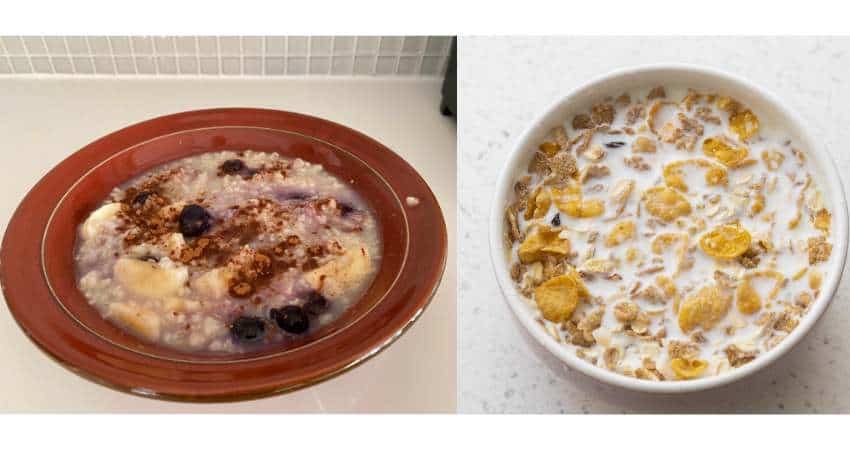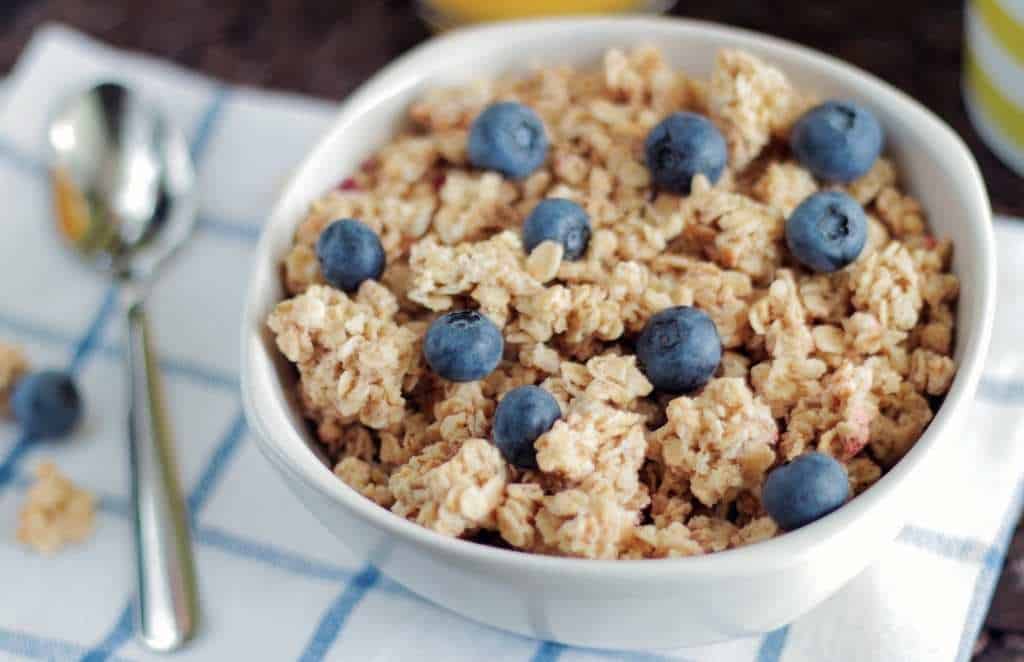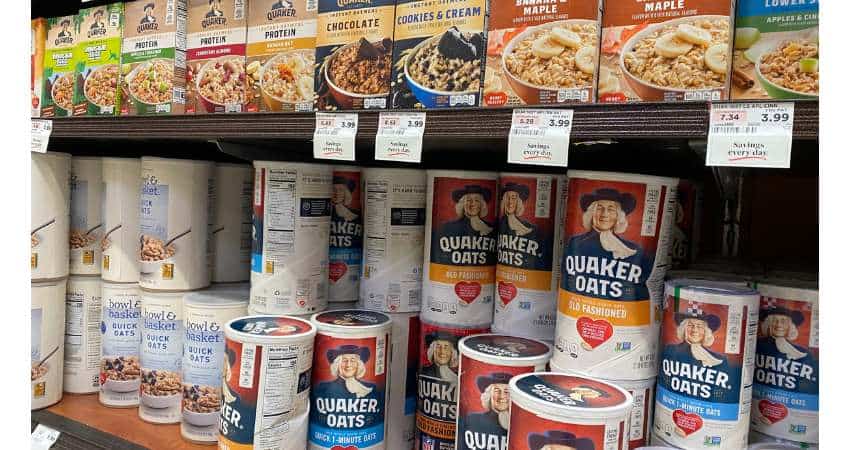Oatmeal vs Cereal – Which is Better? Let’s Compare
Oatmeal and the wide variety of breakfast cereals are two of the most popular breakfast options. Some cereals are considered healthy causing many people to wonder if they can match oatmeal. Let’s answer, is oatmeal better than cereal?
Oatmeal is better than cereal due to its higher percentage of minerals, vitamins, fiber and benefits. Oatmeal doesn’t contain additives or preservatives which cereals contain. Oatmeal makes people feel fuller due to its better satiety score. Breakfast cereals contain more unhealthy sugar and sodium than oatmeal.
This article will include a side-by-side nutrient comparison of healthy cereals and oatmeal. In addition, I’ll compare their costs, glycemic index and satiety index.
As a Certified Health Coach many of my clients have asked me about both foods. For this reason, I’ve researched both foods for clients and my own personal use prior to and during writing this article. I also consume both for many years and continue to do so.

Pros and Cons
Oatmeal Pros
- Served warm and considered a comfort food.
- Make you feel full longer.
- More complete nutrient profile than cereal.
- Less sugar and sodium.
- No preservatives or additives.
- More affordable.
- Oats are naturally gluten free.
Cons
- Take longer to prepare.
- Tastes bland and often needs additional ingredients to taste better.
Cereal Pros
- Served quickly.
- Dry types are easy to take on the go as a snack.
- Tastes sweeter and has more flavor.
- Healthier options available.
Cereal Cons
- Contain more sugar and sodium.
- Contain additives and preservatives which oatmeal doesn’t contain.
- Costs more.
- Less filling.
- Most are not gluten free.
The following video compares both foods and determines which is better:
Oatmeal vs Cereal: Nutrient Comparison
Have you ever noticed how long the cereal aisle is in a supermarket? There are so many brands and types it’s impossible to compare them all.
Therefore, I picked a common cereal known to most as a healthy alternative to the typical high sugar options, Special K. The cereal Total was another option but Special K seems to be more popular.
In addition, I chose an even healthier option, Kashi, which I often eat when I don’t have the time to make oatmeal.
I didn’t find any reason to choose a high sugar option most kids like to eat. I’m unsure anybody would think one of those is as healthy as oatmeal. So, I left out my two childhood favorites, Frosted Flakes and Lucky Charms.
The following table is a side-by-side comparison of the nutrients contained in one cup of Special K, Kashi original and regular cooked oatmeal.
| Oatmeal (1 cup)
Cooked |
Special K (1 cup)
Original |
Kashi Cereal (1 cup)
Original |
|
| Calories | 166 | 117 | 179 |
| Protein | 5.94 g | 5.52 g | 9.8 g |
| Carbohydrates | 28.1 g | 22.8 g | 38.5 g |
| Fiber | 3.98 g | 0.43 g | 10.5 g |
| Fat | 3.56 g | 0.55 g | 1.79 g |
| Cholesterol | 0 mg | 0 mg | 0 mg |
| Sugar | 0.63 g | 3.94 g | 8.58 g |
| Sodium | 9.36 mg | 207 mg | 125 mg |
| Vitamin A | 0 IU | 0 IU | 0 IU |
| Beta-carotene | 0 mcg | 0 mcg | 0 mcg |
| Vitamin C | 0 mg | 21.1 mg | 0 mg |
| Vitamin D | 0 mcg | 1.02 mcg | 0 mcg |
| Vitamin B6 | 0.005 mg | 2.00 mg | 0.07 mg |
| Vitamin B9 (Folate) | 14 mcg | 400 mcg | 55 mcg |
| Vitamin B1 (Thiamin) | 0.17 mg | 0.52 mg | 0.12 mg |
| Vitamin B2 (Riboflavin) | 0.03 mg | 0.59 mg | 0.05 mg |
| Vitamin B3 (Niacin) | 0.52 mg | 7.01 mg | 0.88 mg |
| Vitamin B5 (Pantothenic Acid) | 0.72 mg | 0.01 mg | 0.01 mg |
| Magnesium | 63 mg | 4 mg | 52 mg |
| Phosphorous | 180 mg | 15 mg | 157 mg |
| Potassium | 164 mg | 16 mg | 179 mg |
| Iron | 2.11 mg | 8.68 mg | 2.51 mg |
| Copper | 0.17 mg | 0.05 mg | 0.54 mg |
| Calcium | 21 mg | 7 mg | 80 mg |
| Zinc | 2.34 mg | 0.21 mg | 0.88 mg |
The cereals give oatmeal pretty stiff competition and contain many of the same types of nutrients. This causes many people to ask, which is healthier?
Oatmeal is healthier than cereal due to its complete nutritional profile and fewer sugars and sodium. Cereal contains additives, colorings and preservatives oatmeal doesn’t contain. Oatmeal has a better satiety score which makes you feel full longer and eat less later. Oatmeal has a lower glycemic score.
If we’re comparing Kashi original and cooked oatmeal straight up, Kashi has the better nutritional profile. Kashi original provides a higher percentage of protein, fiber, B vitamins and most minerals.
Although Kashi does have some additives listed on the nutrient label and contains more sugar and sodium. I do eat Kashi on some mornings I don’t have much time to prepare oatmeal.
Overnight oats retain more of their nutrients and contain more than regular cooked oats and Kashi. Check out how many more nutrients in my comparison article.
Here’s another video comparing the nutrients and more in both breakfast foods:
I personally choose oatmeal most days of the week. Sometimes I’ll eat Kashi when I don’t have much time to prepare food.
Glycemic Index
The Glycemic Index (GI) is a scale measuring how fast a particular food raises the blood sugar in the blood4. Blood sugar spikes can lead to health complications with the heart, nerves, kidneys and eyes5.
Knowing the GI of the food consumed is important especially if blood sugar levels are a concern.
How blood sugar levels are affected:
- Foods with a glycemic index 70 or more cause a quicker spike in blood sugar levels.
- Foods with a glycemic index 56 to 69 cause a moderate spike in blood sugar levels.
- Foods with a glycemic index 55 or less cause a slow spike in blood sugar levels.
How foods on the GI scale are categorized as:
- Low-GI foods: 55 or under
- Medium-GI foods: 56-69
- High-GI foods: 70 or over
Knowing how important the glycemic index (GI) is, and how it affects blood sugar, let’s answer, which of the two foods has a higher GI?
The glycemic index of most cereals is higher than oatmeal. Corn flakes have a GI of 93. Grape nuts have a GI of 75. Special K has a GI of 69. Wheat bran cereals have a GI of 55 or less. Rolled oats have a GI of 55 and steel cut oats have a GI under 55.
The table below shows the glycemic index of some cereals and oatmeal from high to low:
| Breakfast Cereals | Glycemic Index |
| Cornflakes | 93 |
| Grape Nuts | 75 |
| Special K | 69 |
| Wheat bran Cereals | 55 or less |
| Rolled oats | 55 |
| Steel cut oats | 55 or less |
| Instant oatmeal | 79 |
Find out how Cream of Wheat compared in my article. Could it be just as good?
Satiety Index
The satiety index is a scale showing how full a person feels after eating a certain food. It was developed in 1995 from a study which tested 38 foods.
Foods scoring under 100 are considered less filling and foods scoring above 100 are considered more filling6.
The table below shows the satiety scores of breakfast foods.
| Breakfast Food w/milk | Satiety Index Score |
| Muesli | 100% |
| Sustain | 112% |
| Special K | 116% |
| Cornflakes | 118% |
| Eggs | 150% |
| All-Bran | 151% |
| Oatmeal w/milk | 209% |
Oatmeal has a better satiety index score than cereal meaning it will make you feel fuller longer. It has a satiety index score of 209%. Breakfast cereals have a satiety score from 112% to 151%.
Of all the 38 total foods, oatmeal scored the fourth highest only beat by oranges, ling fish and boiled potatoes. Of the seven breakfast cereals with milk, oatmeal scored the best.
The best breakfast cereal, All-Bran, had a satiety index score of 151%. Of the 38 foods All-Bran scored the 13th best and the 2nd best of the breakfast foods.
Oatmeal-eaters not only felt fuller longer than their cereal-eating counterparts, they ate less food after.
Food has a high satiety score for the following reasons:
- High in fiber
- High in protein.
- High in volume (foods containing a lot of water or air).
- Low in energy density (foods low in calories for their weight).
Find out how brown rice compared in my article.

Taste and Texture
Many times, people will pick a particular food over the other for its taste. To break the boredom, it’s not always about the nutrients. Cravings and moods have to be satisfied sometimes also.
Since both are breakfast foods, many people wonder how their tastes compare.
Oatmeal and cereal have different tastes and textures. Oatmeal is bland compared to cereal which has more flavor and sweetness due to added sugar and sodium. Some healthier cereals taste bland too but are less earthy. Oatmeal has a creamier texture than the drier, more crunchy cereal.
Cereal will get soggier and less crunchy if it sits in milk for a longer time.
Instant or quick oats have a creamier texture than the chewier rolled or steel cut oats.
To conduct some original research, I polled people in food groups and some of my readers. I asked, which one do you prefer for breakfast?
- 66% said they preferred the taste of oatmeal.
- 30% said they preferred the taste of cereal.
- 4% said they had no preference.
For more research I’d thought it would be fun to setup and conduct my own taste test at home. 75% of us chose oatmeal in the taste test.
Find out how grits compares and which one has the better satiety in my article.
Gluten-Free
Oats are naturally gluten-free although some oats made for oatmeal may come into contact with gluten products, or cross-contamination is possible with machinery or during storage. Always check the label of your food for the gluten free label.
Most breakfast cereals found in the supermarket are not gluten free. There is one exception, Cherrios which is labeled gluten free and is made from whole grain oats.
Important: Although oats are gluten free, they may come in contact with gluten-containing grains in storage or during transportation. Most of the Quaker products have solved this issue and label those products gluten free. Always check the label of your food products to determine if its gluten free.
Find out how quinoa compared to oats in my article.

The Prices
With inflation skyrocketing it seems every trip to the supermarket results in the price higher than the last time. In addition, it seems I have less groceries in my cart.
If you would like to spend less money at the supermarket, then the cost of food certainly matters. In some situations, the price may sway your decision about which food to choose more often. Therefore, let’s compare the prices of both foods.
Cereal costs 190% more than oatmeal per serving. The average price for oatmeal is $0.18 per 40 gram serving. The average price for cereal is $0.53 per serving.
To conduct more original research, I searched the following two supermarkets to compare the price of both.
First, I visited the Shoprite supermarket:
- Wholesome Pantry Organic old-fashioned regular oats
- $2.49 per 18 oz container (13 servings) equaling $0.19 per 40 g serving.
- Special K Original
- $5.29 per 19 oz box (9 servings) equaling $0.59 per 59 g serving.
- Kashi GO Original
- $4.29 per 13.1 oz box (6 servings) equaling $0.71 per 58 g serving.
- Cinnamon Toast Crunch
- $5.49 per 16.8 oz box (11 servings) equaling $0.50 per 41 g serving.
I then checked Walmart:
- Quaker Old-Fashioned Oats
- $4.98 per 42 oz container (30 servings) equaling $0.17 per 40 g serving.
- Special K Original
- $3.98 per 18 oz box (13 servings) equaling $0.31 per 39 g serving.
- Kashi GO original
- $5.38 per 20.5 oz box (10 servings) equaling $0.54 per 58 g serving.

Oatmeal vs Baby Cereal vs Baby Food
There are so many baby food types on the market. They also have oat baby cereal and baby rice. When it comes time for your baby to consume solid food instead of formula, the choices are endless.
First, the safety of your child is the most important. This is why it’s important to follow the recommendations of your pediatrician.
Find out if granola had more nutrients in my comparison article.
The following video provides you with an easy oatmeal recipe:
Additional Article Resources789
If you have any questions about this article don’t hesitate to email us. You can find an email on our contact page.
Read Next – More Food Articles!
Eggs vs Oatmeal – Which Is Better? Let’s Compare
Muesli vs Oatmeal – What’s The Difference? Let’s Compare
Steel Cut Oatmeal vs Oatmeal: Which Is Better? Let’s Compare
Oatmeal vs Rice: Which Is More Healthy? (We Find Out)
- USDA: Cereals, oats, regular and quick, unenriched, cooked with water, without salt [↩]
- USDA: Cereal (Kashi GOLEAN) [↩]
- USDA: Cereal (Kellog’s Special K) [↩]
- Harvard Health Publishing: Glycemic index for 60+ foods [↩]
- National Institute of Diabetes and Digestive and Kidney Diseases: Know Your Blood Sugar Numbers: Use Them to Manage Your Diabetes [↩]
- National Center for Biotechnology Information: A satiety index of common foods [↩]
- Oxford Academic: Different glycemic indexes of breakfast cereals are not due to glucose entry into blood but to glucose removal by tissue [↩]
- National Center for Biotechnology Information: The Benefits of Breakfast Cereal Consumption: A Systematic Review of the Evidence Base [↩]
- National Center for Biotechnology Information: Instant Oatmeal Increases Satiety and Reduces Energy Intake Compared to a Ready-to-Eat Oat-Based Breakfast Cereal: A Randomized Crossover Trial [↩]
